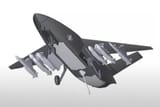S. Korea is developing LHD with EMALS
https://armyrecognition.com/news/navy-news/2025/south-korea-develops-stealth-attack-drone-to-enhance-naval-strike-capabilities-in-high-risk-maritime-zones
>Developed by Hanwha Ocean, this vessel was presented at the MADEX 2025 naval exhibition in Busan and is designed as a multipurpose command ship, displacing approximately 42,000 tons. With a length of 240 meters and a width of 60 meters, the vessel features at least one electromagnetic catapult, three arresting cables, a well deck for amphibious landing operations, and vertical launch systems for surface-to-air missiles. The Ghost Commander-II is intended to support a variety of missions, including long-range strike, amphibious support, disaster relief, and sea lane protection, in a context where naval doctrine increasingly integrates artificial intelligence and uncrewed aerial assets.
>According to KAI, integration with electromagnetic launch systems is essential, and the South Korean defense industry is currently developing an 8-ton electromagnetic catapult, with a future goal of scaling to 20 tons for heavier platforms. KAI has also mentioned the potential of producing a variant capable of ski-jump takeoffs using canards and thrust vectoring nozzles, as an alternative if EMALS integration proves challenging.
How hard is it to develop EMALS on your own?
Anonymous
7/11/2025, 8:07:57 PM
No.63969881
>The UCAV concept was initially developed as part of a broader manned-unmanned teaming framework, which includes KAI’s participation in the development of the KF-21 Boramae fighter and supporting drone systems such as the Low Observable Unmanned Wingman System (LOWUS). The naval UCAV is larger than LOWUS and differs from it in terms of payload capacity, structural reinforcement, and operational independence. The drone’s maximum takeoff weight is under six tons, with a payload capacity of 800 kilograms and a combat radius of approximately 482 kilometers. It is powered by a high-bypass turbofan engine and is expected to cruise below Mach 0.6. The nose section is designed to be modular, allowing for the integration of AESA radar, IRST, EOTS, and potentially maritime surveillance radars in future variants. In addition to its ability to carry the Meteor long-range air-to-air missile, the UCAV will be equipped with small and medium air-launched drones developed by KAI. These allow it to function as a drone mothership, capable of managing multiple subordinate drones during coordinated operations.
Anonymous
7/11/2025, 8:30:38 PM
No.63969989
>>63969846 (OP)
Drones are lighter than manned jets so the EMALS doesn’t need to be as advanced
Anonymous
7/11/2025, 9:36:54 PM
No.63970251
reminds me of playing Carrier Command back in the 80s
Anonymous
7/11/2025, 9:54:36 PM
No.63970330
>>63972208
>>63969846 (OP)
Didn't they also claim to be developing a supercarrier and a bunch of other bullshit? It just sounds like implessive posting
Anonymous
7/12/2025, 6:42:35 AM
No.63972208
>>63970330
>Didn't they also claim to be developing a supercarrier and a bunch of other bullshit?
No, they just thought it's too ravish. So they've turned to just a carrier+landing ship design and this is the result.
they probably should just go for nukes first.
that takes away the worry of being invaded by the north.
Anonymous
7/12/2025, 7:46:28 AM
No.63972402
>>63973836
>>63972213
They will have nukes when the north unifies Korea.
Anonymous
7/12/2025, 5:25:27 PM
No.63973752
>>63972213
they could build nukes in less than a month. it doesn't solve anything
Anonymous
7/12/2025, 5:55:14 PM
No.63973836
>>63973936
>>63972402
>when the north unifies Korea.
Yup. After toppling the Kim dynasty and seeking reunification 1990s Germany-style
Anonymous
7/12/2025, 6:28:35 PM
No.63973936
>>63976193
>>63973836
Absorbing the Norks seems like a good way to buy some time to fix the demographic crisis out there
Anonymous
7/13/2025, 5:53:27 AM
No.63976193
>>63976208
>>63969846 (OP)
>vapor ware
Do they even have funding for this? When do they even expect to have it operational if at all?
>>63973936
Apparently they started down the path to increasing birth. I think one of only two developed countries recently to do it without using mass immigration.
Anonymous
7/13/2025, 5:58:53 AM
No.63976208
>>63976293
>>63976193
Yeah I'll believe it when I see it. I've seen similar articles about countries having a temporary boost in births only for it to drop off. I very much doubt they've gone from a .78 birth rate to above replacement in 1 year.
>I think one of only two developed countries recently to do it
Which other country are you talking about? As far as I'm aware no country has been able to do that.
Anonymous
7/13/2025, 6:32:10 AM
No.63976293
>>63978228
>>63978260
>>63976208
Hungary increased their birthrate from 1.1 to 1.6 but it took them about 7 years. I just checked and Korea has 13 months now of straight increase in births but, at their rate, they are still about a decade off from reaching their goal of 1.5-1.6 which is where they want to be.
Granted declining birth rates don't happen over night and they don't reverse over night either. We'll see though. I hope it works for them so we have a newer model to follow without relying on immigration.
Anonymous
7/13/2025, 5:02:51 PM
No.63978228
>>63976293
>Hungary increased their birthrate from 1.1 to 1.6 but it took them about 7 years.
The majority of the new borns in Hungary are gypsies.
Anonymous
7/13/2025, 5:05:29 PM
No.63978245
>>63972213
Nukes are overkill. Both countries have the ability to flatten the other with conventional weaponry alone. And it wouldn't take more than a day.
Anonymous
7/13/2025, 5:07:34 PM
No.63978260
>>63976293
Well I certainly hope they succeed and other countries follow suit, I'm just not sure it'll work without more drastic measures.
Anonymous
7/14/2025, 1:59:20 AM
No.63980778
>>63969846 (OP)
>EMAILS
Well yeah how else are you gonna communicate?



